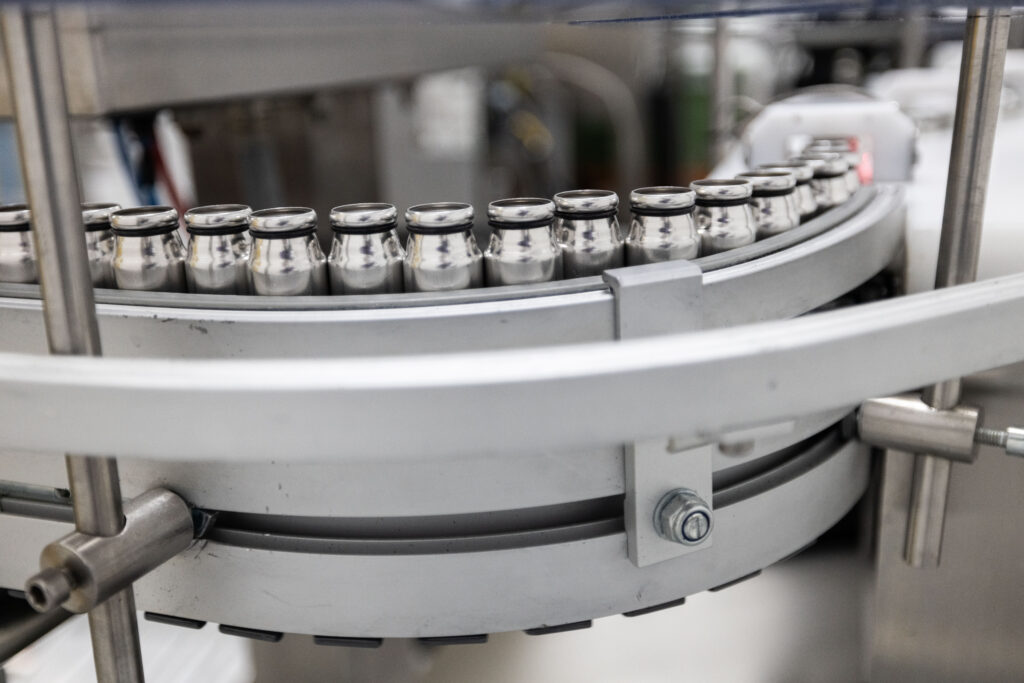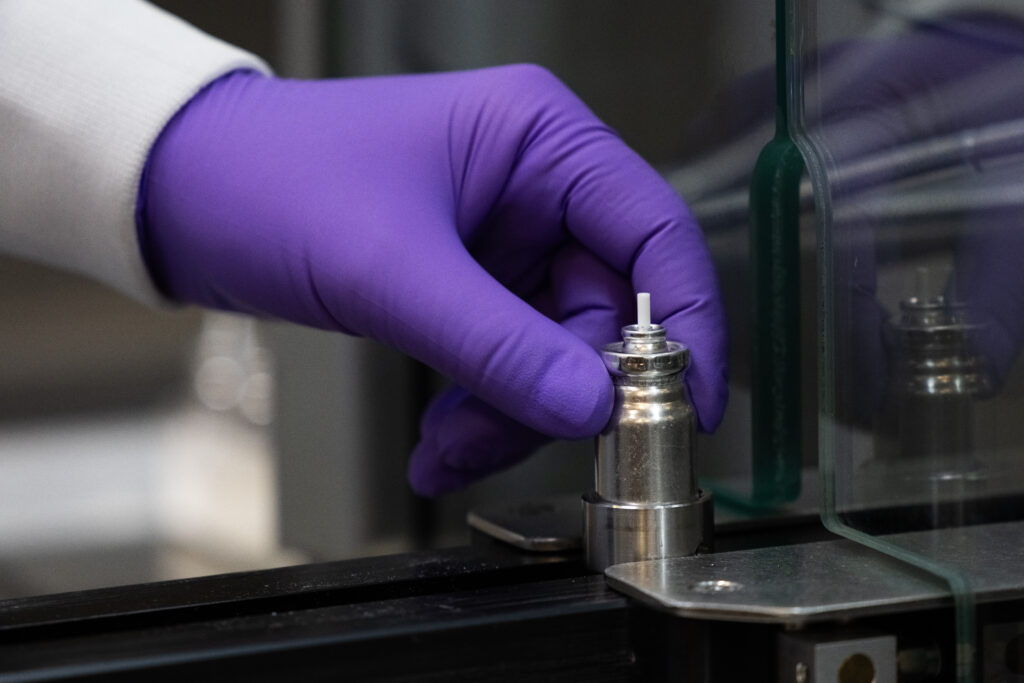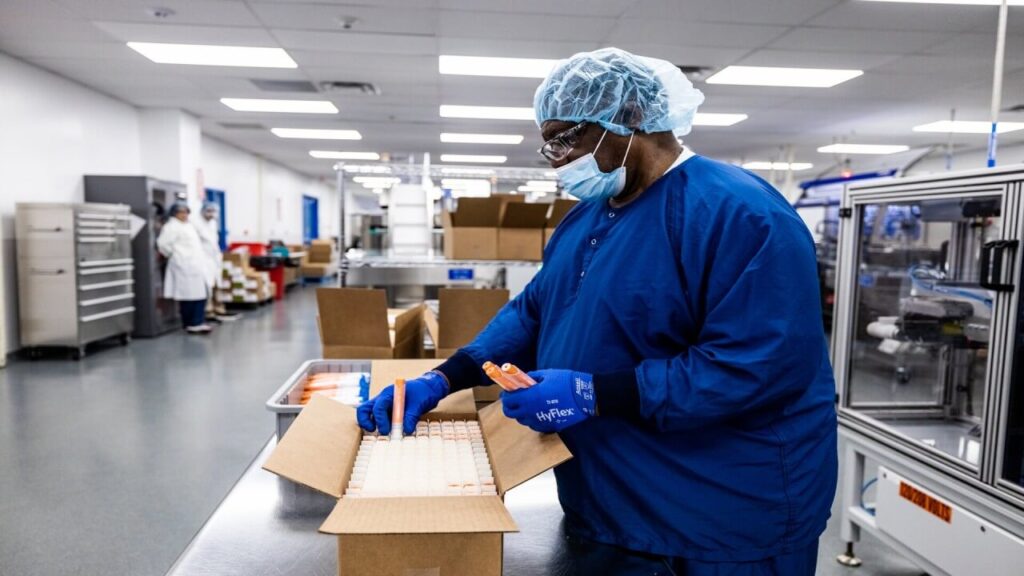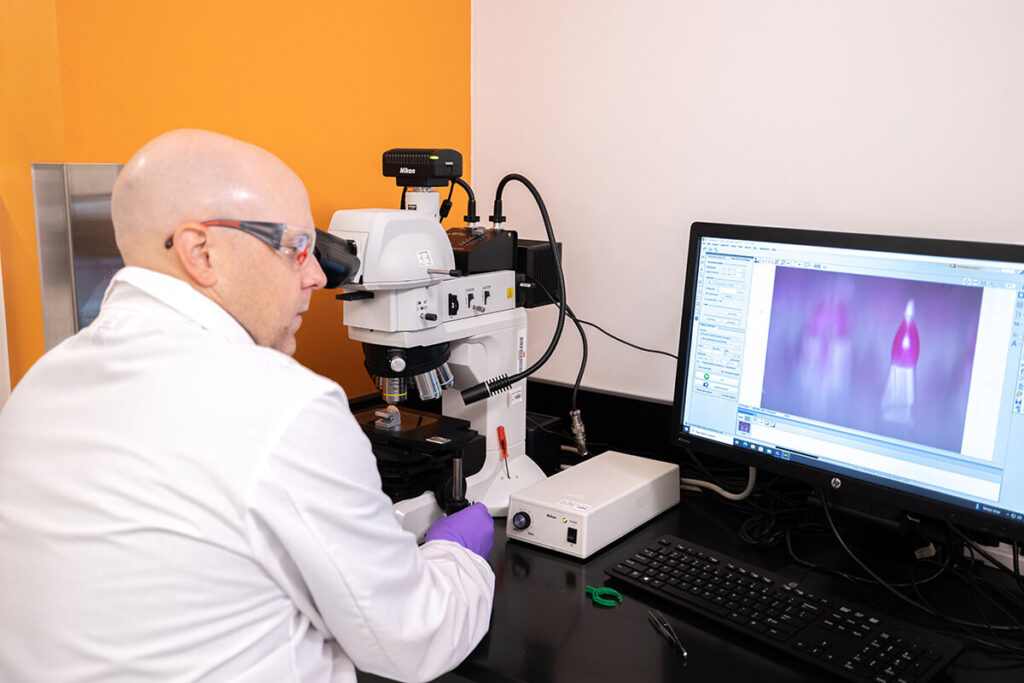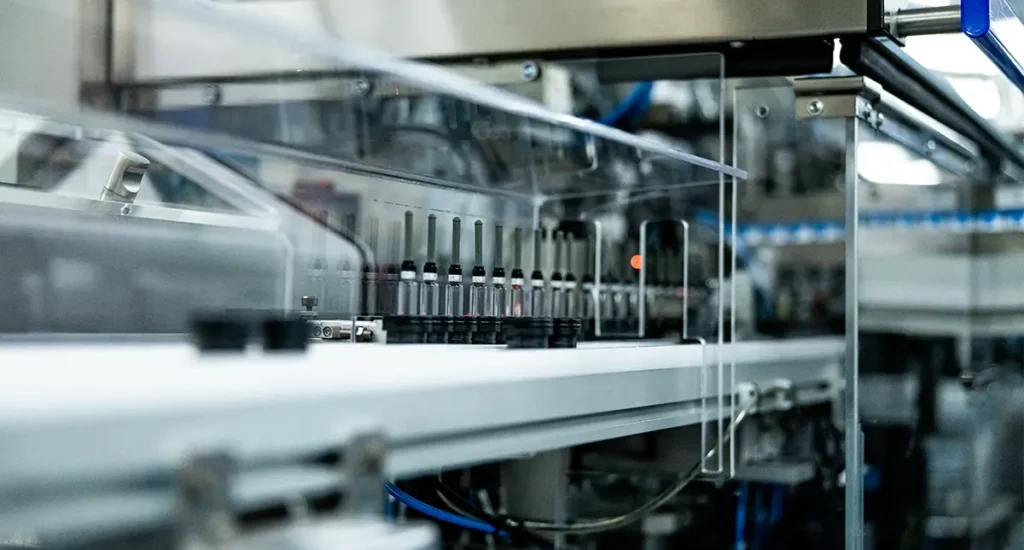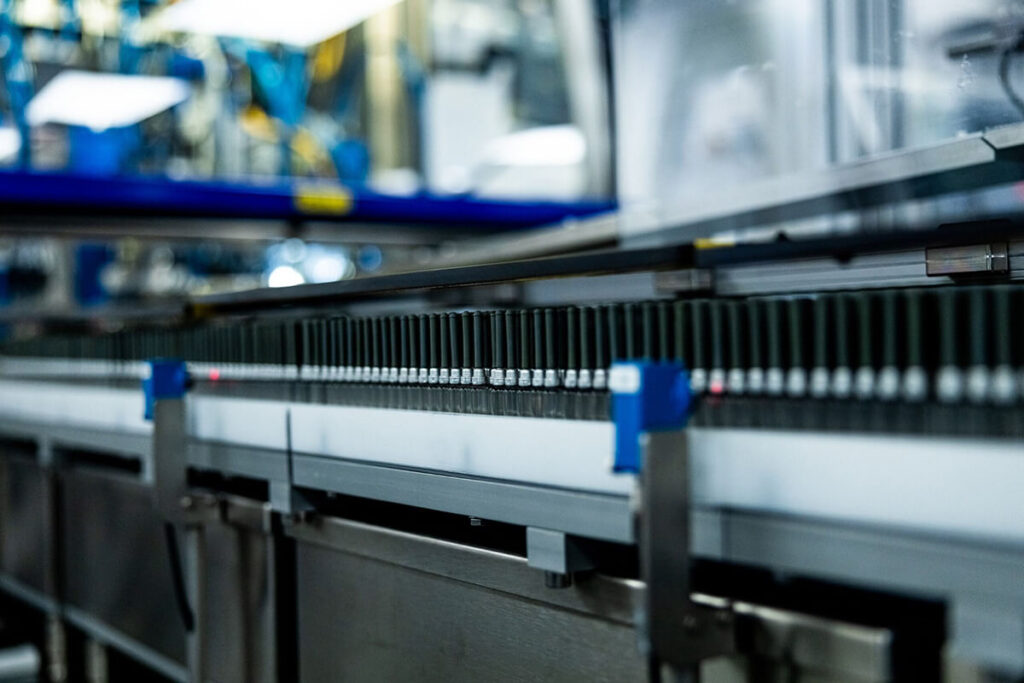Home / Knowledge hub /
Opportunities and challenges for inhalation drug delivery of biologics
July 18, 2024

The biopharmaceutical industry is experiencing a transformative shift toward the development of biologic drugs, particularly in the realm of inhaled drug delivery. A significant portion of biologics, approximately 10%, are being developed for respiratory delivery.1 This burgeoning pipeline includes a diverse array of molecules and targets. However, this approach also presents unique formulation and device engineering challenges to ensure effective delivery.
Unlocking therapeutic potential through inhaled drug delivery
While most current vaccines and other biologics are administered via injection, delivering these large molecules directly to the respiratory tract through inhalation offers several compelling advantages. The mucosal surfaces of the lungs and nasal cavity serve as prime entry points for many pathogens, making inhaled delivery an intuitive approach for inducing a localized response.
For vaccines specifically, inhaled administration can effectively stimulate all three arms of the immune system: cellular immunity to eliminate infected cells, humoral immunity to produce circulating antibodies, and critically, mucosal immunity comprising secretory antibodies that provide the first line of defense at mucosal surfaces.2 This integrated immune activation at the pathogen’s entry point could enable more robust and durable protection.3
Beyond vaccines, inhaled biologics present opportunities across a wide range of respiratory indications. By delivering therapeutics directly to the target tissues, higher localized drug concentrations can potentially be achieved with lower systemic exposure. Needle-free administration also addresses the common fear of injections, which may be a barrier to treatment adherence.4
From a product perspective, inhaled powder formulations of biologics may offer extended stability at room temperature, eliminating cold chain requirements. This could significantly increase accessibility and enable self-administration.
Overcoming technical challenges
While the potential benefits of inhaled biologics are considerable, the physicochemical properties of biologic drugs, such as their molecular size, charge, and conformational stability, present unique formulation challenges. Achieving efficient pulmonary or nasal delivery necessitates careful optimization of the drug formulation and inhalation devices.
Given the large doses involved, nebulizers and dry powder formulations are often the most suitable delivery methods.5 Each approach has its own intricacies in terms of formulation design, manufacturing processes, and device engineering considerations.
Nebulizers
Nebulizers, which aerosolize liquid drug formulations into inhalable droplets or particles, represent a promising delivery modality for inhaled biologics, particularly for larger molecule and higher dose applications. They are also well-suited for fast development. However, this approach also faces unique technical hurdles.
One major consideration is the potential for protein instability and degradation due to the stresses involved in the nebulization process. Jet nebulizers, which rely on compressed gas to atomize the liquid, expose proteins to high shear forces as the drug recirculates through the nebulizer multiple times before being emitted as aerosol droplets. This can compromise the structural integrity of delicate biologic molecules. Vibrating mesh nebulizers provide a gentler alternative, generating aerosols as the liquid is extruded through a vibrating mesh aperture in a single pass. Vibrating mesh nebulizers also excel in terms of efficiency, with less dead volume and therefore less potential to waste the drug product.
Achieving efficient lung deposition of the nebulized aerosol is another key challenge. The ideal aerodynamic particle size range is around 3-6 microns, resulting in 60-80% regional deposition in the lungs.6 Larger droplets may be filtered out in the upper airways, while smaller ones run the risk of being exhaled. However, optimizing droplet size requires a trade-off between higher mean lung deposition and lower variability.7
In order to overcome these challenges, a focus on efficient dose delivery is essential. Synchronizing the delivery of the aerosol with breath, delivering during inspiration and thus avoiding product loss during exhalation, is a potential solution. Additionally, ensuring aerosols are within the respirable range can help improve dose delivery efficiency and consistency.
Dry powder formulations
For molecules that are sensitive to moisture, dry powder is a more suitable route than nebulizers. Dry powder formulations are often produced through spray drying. This process is particularly suited for producing inhaled biologics due to its efficiency and ability to handle delicate biologics (even living cells). By optimizing spray drying processes, manufacturers can produce low-density, dispersible powders that can be delivered efficiently with simple device mechanisms.
The spray drying process introduces several physical stresses, including heat. Evaporative cooling maintains the droplet at just above room temperature, completing liquid evaporation within a few milliseconds and keeping the protein below the inlet temperature. As the particle heats, it approaches the outlet temperature, making this parameter one of the most relevant for minimizing the impact on protein structure.8
The creation of core-shell particles is a pivotal aspect of spray drying to mitigate stability issues.9 Shell-forming excipients, which are responsible for the micromeritic properties of the powder, migrate to the surface during drying, encapsulating the protein within the particle’s core. This configuration enhances protein stability by minimizing exposure to the air-liquid interface. Within the core, where the protein is intended to reside, stability is further maintained using glass-forming agents, buffers, antioxidants, and other stabilizers.
By controlling feedstock composition and evaporation rates, it is possible to tailor the size and structure of particles in dry powder formulations. The shell-forming excipient plays a critical role in determining particle size and morphology. Spray-dried core-shell particles can reduce oligomer formation, contributing to their stability advantages and potentially minimizing immunogenicity.
To improve lung deposition and minimize oropharyngeal deposition, it is essential to manage the aerodynamic diameter of the particles. Targeting primary particles with a corrugated surface, facilitated by shell-forming excipients, helps achieve higher lung doses, as smooth particles tend to result in lower total lung deposition.10 This corrugated morphology, along with controlled particle size, allows for manipulation of the aerodynamic properties to bypass deposition in the mouth and throat.
Proper packaging also plays a crucial role in maintaining the stability of dry powder formulations. Ensuring a tight moisture barrier is vital for extending the shelf life of these products. The stability and performance of the spray-dried powders are maintained at room temperature, unlike liquid formulations that require refrigeration, offering logistical benefits.
Harnessing the potential of inhaled biologics
Inhalation drug delivery may enhance therapeutic efficacy, minimize side effects, and/or improve patient compliance. However, the journey from concept to market involves overcoming significant technical challenges, particularly in formulation and device engineering.
To dive deeper into considerations for inhaled biologics, we invite you to download Kindeva’s recent webinar on the topic. The presentation features insights from John Patton, Head Kindeva SAB, Kindeva Drug Delivery; Keith Ung, Director and Bay Area Site Head, Kindeva Drug Delivery; Andy Clark, President and General Manager, Aerogen Pharma Corporation; and Jeff Weers, Chief Technology Officer, Cystetic Medicines, Inc.
Download your copy to discover a wide range of biologics expertise.
References
1 Gavtash, B. Kindeva and Pharmacircle. (2024).
2 Holmgren, J., and Czerkinsky, C. Mucosal immunity vaccines. Nature
Medicine Supplement. Volume 11:S45-54 (2005).
3 Waldeman, R.H., et al. Aerosol Delivery, But Not IM Injection, of Adenovirus-Vectored Tuberculosis (TB) Vaccine Induced Respiratory Mucosal Immunity in Humans. (1969) JAMA 207:520-524.
4 McLenon, J., and Rogers, M.A.M. The fear of needles: A systematic review and meta‐analysis of 35 studies. J Adv Nurs. (2019);75:30–42.
5 Clark, A.R. Half a Century of Technological Advances in Pulmonary Drug Delivery: A Personal Perspective. Frontiers in Science. (2022).
6 Clark, A.R. The use of laser diffraction for the evaluation of aerosol clouds generated by medical nebulizers. International Journal of Pharmaceutics 115 (1995): 69-78.
7 Clark, A.R. Essentials for aerosol delivery to term and pre-term infants. Ann Transl Med. 2021 Apr; 9(7): 594.
8 Snyder, H., and Lechuga-Ballesteros, D. Spray Drying: Theory and Pharmaceutical Applications, Lachmann and Liebermann, 3rd ed., 1008.
9 Vehring, R. Pharmaceutical particle engineering via spray drying. Pharm Res. (2004); 25:999-1022.
10 Ung, K., Weers, J., Huang, D., et al. Targeted delivery of spray-dried formulations to the lungs. WO (2017).
Related resources
Explore our other resources to discover valuable insights on the latest trends in drug delivery.
The impact of inlet design on HFA-152a pMDI drug delivery
When assessing aerodynamic particle size distribution (APSD) using the Next Generation Impactor (NGI), throat model selection can significantly influence drug deposition outcomes. Accurate deposition data is essential for optimising pMDI design and ensuring consistent, effective drug delivery to patients. Recent research by our pulmonary/pMDI experts—Aaron Taylor, Chad Haraldson, and Stephen Stein at Kindeva—explores how United […]
Learn MoreEvaluating extractables in low-GWP pMDI formulations
As the pharmaceutical industry advances toward low global warming potential (GWP) propellants like HFA152a and HFO1234ze(E), understanding material compatibility becomes critical, especially when it comes to leachables from common device components. In a recent evaluation, a group of pulmonary experts at Kindeva assessed the extractable levels associated with various polybutylene terephthalate (PBT) suppliers in pressurized […]
Learn MoreThe three key trends that will most impact drug development in 2025
The speed of change in the drug development and manufacturing sector requires its stakeholders to be proactive in understanding and addressing key trends and directions the industry is taking. As a global market of considerable size and significance, the value of which is anticipated to grow from $589.06 billion in 2024 to $632.71 billion in […]
Learn MoreMicroneedle array patch characterization recording
Microneedle array patches (MAPs) have the potential to transform delivery of medications and vaccines. While this innovative drug delivery format could result in improved efficiency across a wide range of therapeutics, it also brings critical challenges. To successfully move from concept to commercialization, MAP manufacturers must consider scalability, regulatory compliance, and other complexities. In this […]
Learn MoreMicroneedle array patch characterization presentation
Microneedle array patches (MAPs) are a transformative innovation in drug delivery, with the potential to redefine how medications and vaccines reach patients. MAPs promise a simpler, more effective way to deliver a wide range of therapeutics, but their journey from concept to commercialization is filled with critical challenges. From scaling manufacturing to ensuring regulatory compliance, […]
Learn MoreAddressing top tech transfer challenges
Technology transfer represents a critical bridge between development and commercial manufacturing. This complex process — moving product and process knowledge between development and manufacturing teams or between different manufacturing sites — demands precision at every stage. The implications of technology transfer extend beyond knowledge sharing. Each decision during this process directly impacts manufacturing efficiency, regulatory […]
Learn MoreTech transfer commercial manufacturing mindset
Technology transfer (tech transfer) moves product and process knowledge between teams or partners and acts as a crucial bridge between ideation and commercialization. Especially for complex products like sterile injectables, a smooth tech transfer process is essential. In this white paper, discover valuable strategies to embrace a commercial manufacturing mindset from day one. Download your […]
Learn MoreHFA152a green propellant capabilities
With evolving regulations and a growing push for sustainability, switching pressurized metered-dose inhalers (pMDIs) to green propellants is becoming increasingly essential. One of the most promising low global warming potential (GWP) options is HFA152a. In this white paper, we share insights on transitioning to HFA152a. Download your copy to discover: An overview of sustainability regulations […]
Learn MoreSterile product introduction and tech transfers in a crowded market
The tech transfer landscape for sterile products is increasingly complex, with pressure to reduce time to market. Find out how to navigate common challenges and avoid costly delays or oversights in this presentation from our Director, Client Portfolio & Relationship Management, Kim Brown. Download your copy to explore: Benefits of a commercial manufacturing mindset How […]
Learn MoreLet’s transform tomorrow together
Every patient deserves a brighter tomorrow. As your strategic partner, we are dedicated to building your lasting legacy and helping you fast-track healthier tomorrows. You dream it, we deliver it.
